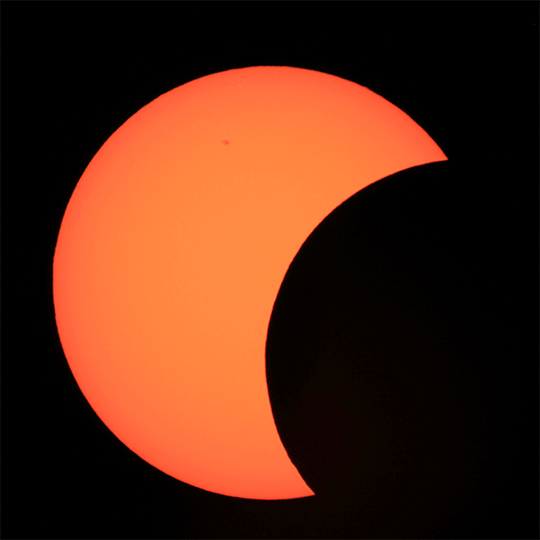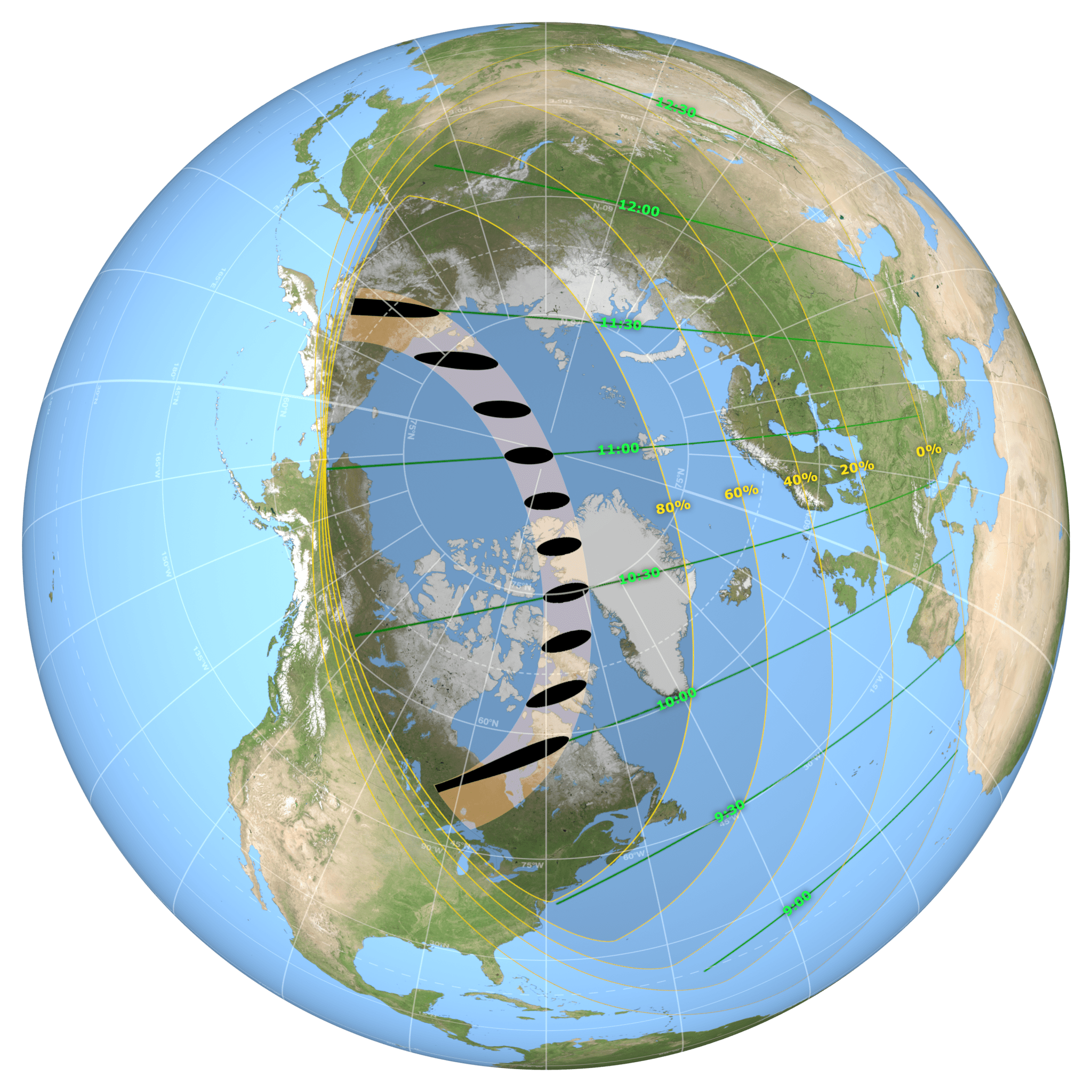On Thursday, June 10, 2021, people across the northern hemisphere will have the chance to experience an annular or partial eclipse of the Sun.
A solar eclipse happens when the Moon moves between the Sun and Earth, casting a shadow on Earth, fully or partially blocking the Sun’s light in some areas. During an annular eclipse, the Moon is far enough away from Earth that the Moon appears smaller than the Sun in the sky. Since the Moon does not block the entire view of the Sun, it will look like a dark disk on top of a larger, bright disk. This creates what looks like a ring of fire around the Moon. People in parts of Canada, Greenland, and northern Russia will experience the annular eclipse.
In some places, viewers won’t get to see this ring around the Moon. They’ll instead experience a partial solar eclipse. This happens when the Sun, Moon, and Earth are not exactly lined up. The Sun will appear to have a dark shadow on only part of its surface. Viewers in parts of the eastern United States and northern Alaska will see a partial solar eclipse on June 10, along with much of Canada and parts of the Caribbean, Europe, Asia, and northern Africa.
In the United States, the partial eclipse will be visible along parts of the Southeast, Northeast, Midwest, and in Northern Alaska. In many of these locations, the eclipse will occur before, during, and shortly after sunrise. This means that viewers will need to get a clear view of the horizon during sunrise in order to see the eclipse.
To see exactly where the eclipse will be visible, check out our animations and maps. You can learn more about these maps from NASA’s Scientific Visualization Studio.
Credits: NASA’s Scientific Visualization Studio/Ernie Wright
To learn which times the eclipse may be visible in certain areas, you can click anywhere on the map here. (Note that the maximum obscuration and maximum eclipse timing noted on this map may occur before sunrise in many locations.)
Download this fact sheet to learn more about eclipses, how to view them safely, and fun eclipse activities:
Solar Eclipse Fact Sheet
Live Stream
Weather permitting, a view of the partial solar eclipse will be streamed on YouTube and on nasa.gov/live. This stream is courtesy of Luc Boulard of the Royal Astronomical Society of Canada Sudbury Centre.
The stream will start at 5 a.m. EDT. Since sunrise isn’t until 5:47 a.m. EDT, the stream will be dark until then. The eclipse will be nearly at maximum (~90 percent coverage) at sunrise, so viewers can watch the Sun reappear as the Moon moves out of the way. This stream will show the partial, not annular, solar eclipse.
How to Safely Watch an Annular or Partial Eclipse
It is never safe to look directly at the Sun’s rays, even if the Sun is partly or mostly obscured. When watching a partial solar eclipse or annular solar eclipse, you must wear solar viewing or eclipse glasses throughout the entire eclipse if you want to face the Sun. Solar viewing or eclipses glasses are NOT regular sunglasses; regular sunglasses are not safe for viewing the Sun.
If you don’t have solar viewing or eclipse glasses, you can use an alternate indirect method, such as a pinhole projector. Pinhole projectors shouldn’t be used to look directly at the Sun, but instead to project sunlight onto a surface. Read a how-to guide for creating a pinhole viewer.
Credits: NASA’s Goddard Space Flight Center
Eclipse del 10 de junio de 2021
El jueves 10 de junio de 2021, muchos habitantes del hemisferio norte tendrán la oportunidad de experimentar un eclipse de Sol anular o parcial.
Un eclipse solar ocurre cuando la Luna se sitúa entre el Sol y la Tierra, proyectando una sombra sobre la Tierra y bloqueando total o parcialmente la luz de Sol en algunas zonas. Durante un eclipse anular, la Luna está lo suficientemente lejos de la Tierra para que el satélite parezca más pequeño que el Sol en el cielo. Como la Luna no bloquea la vista completa del Sol, se verá como un disco oscuro encima de un disco más grande y brillante. Esto crea lo que parece ser un anillo de fuego alrededor de la luna. Los habitantes en partes de Canadá, Groenlandia y el norte de Rusia vivirán la experiencia del eclipse anular.
En algunos lugares, los observadores no podrán ver este anillo alrededor de la Luna. En cambio, verán un eclipse solar parcial. Esto ocurre cuando el Sol, la Luna y la Tierra no están exactamente alineados. El Sol parecerá tener una sombra oscura solo en una parte de su superficie. Los observadores en partes del este de los Estados Unidos y el norte de Alaska verán un eclipse solar parcial el 10 de junio, junto con la mayor parte de Canadá y regiones del Caribe, Europa, Asia y el norte de África.
En los Estados Unidos, el eclipse parcial será visible en partes del sureste, el noreste, el medio oeste y el norte de Alaska. En muchos de estos sitios, el eclipse ocurrirá antes, durante y poco después del amanecer. Esto significa que los observadores necesitan tener una vista despejada del horizonte durante el amanecer para poder ver el eclipse.
Para ver exactamente dónde será visible el eclipse, mira nuestras animaciones y mapas. Puedes saber más sobre estos mapas desde el Estudio de Visualización Científica de la NASA.
Credito: Estudio de Visualización Científica de la NASA/Ernie Wright
Para saber a qué hora puede ser visible el eclipse en ciertas zonas, puedes hacer clic en cualquier lugar del mapa aquí. (Observa que los tiempos de oscurecimiento máximo y eclipse máximo indicados en este mapa pueden ocurrir antes del amanecer en muchos sitios.)
Descarga esta hoja informativa para saber más acerca de los eclipses, cómo verlos de forma segura y actividades divertidas para el eclipse.
Hoja informativa de un eclipse solar
Cómo observar un eclipse anular o parcial sin peligro
Nunca es seguro mirar directamente a los rayos del Sol, incluso si el Sol está parcial o totalmente oscurecido. Al observar un eclipse solar parcial o un eclipse solar anular, debes usar lentes solares o para ver eclipses durante todo el eclipse si quieres ver el Sol de frente. Los lentes solares o para eclipses NO son gafas comunes; las gafas de sol comunes no son seguras para ver el Sol.
Si no tienes lentes solares o lentes para eclipses, puedes usar un método alternativo de visión indirecta, como un proyector estenopeico (de agujero). Los proyectores estenopeicos no deben ser usados para mirar al Sol directamente, sino para proyectar la luz solar sobre una superficie.
Credits: Centro de Vuelo Espacial Goddard de la NASA

























